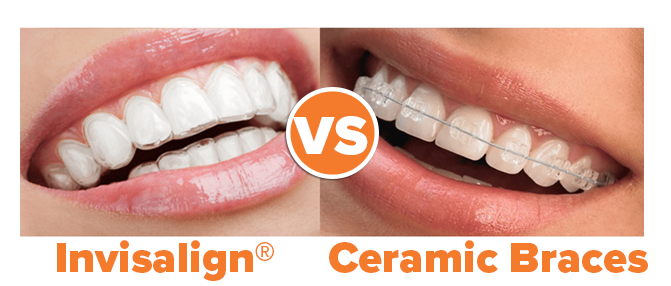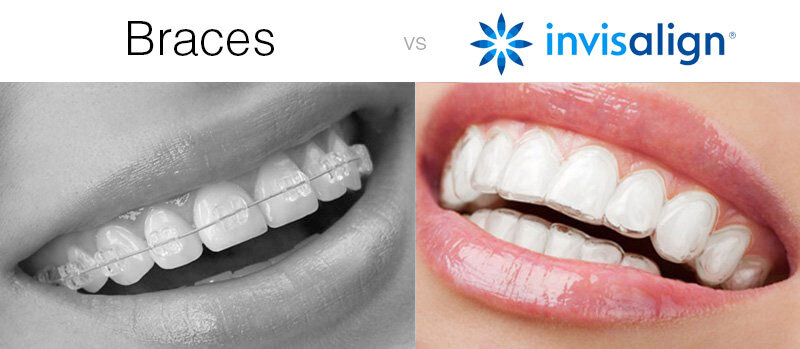Invisalign for Teens: A Modern Solution to Straightening Young Smiles
Invisalign vs. Typical Dental braces: Which Choice Is Right for You?
When taking into consideration orthodontic treatment, the selection between Invisalign and conventional dental braces offers numerous vital elements that merit cautious assessment. Invisalign offers a very discreet option with removable aligners, while typical dental braces offer a much more visible yet effective service for serious imbalance.
Summary of Treatment Alternatives

In comparison, traditional dental braces contain steel braces and wires that are bound to the teeth. This technique uses continual stress in time to achieve positioning. While reliable for complex orthodontic concerns, standard braces require normal sees for modifications and can posture difficulties in maintaining oral hygiene due to the trouble of cleaning up around braces and cords.
Both options have their qualities, and the choice commonly depends upon certain oral problems, way of life choices, and individual compliance. Eventually, consulting an orthodontic specialist is essential for identifying the most ideal treatment plan tailored to specific demands. Recognizing the subtleties of each option can significantly affect the overall success of orthodontic treatment.
Aesthetic Considerations
A substantial element influencing the selection between Invisalign and traditional dental braces is the visual allure each treatment offers. Invisalign aligners are crafted from clear plastic, making them basically undetectable when worn.
On the other hand, traditional dental braces consist of steel brackets and cords, which can be much more noticeable. While improvements in orthodontic modern technology have actually led to the advancement of smaller brackets and tinted elastics, conventional braces still keep a more obvious profile. For some individuals, the presence of braces might prevent them from seeking needed treatment.
Eventually, the selection between Invisalign and standard braces might depend upon individual choices concerning aesthetic appeals. People who prioritize discernment often favor Invisalign, while those that are much less concerned regarding visibility might opt for conventional dental braces. Recognizing the aesthetic implications of each choice is vital for making an informed decision that lines up with one's way of living and choices.
Convenience and Convenience

In regards to ease, Invisalign aligners are detachable, allowing clients to enjoy their favored foods without limitation and maintain optimum dental hygiene. Cleaning and flossing are simplified, as the aligners can be taken out throughout these routines, whereas traditional dental braces need careful navigating around brackets and wires.
In contrast, standard dental braces necessitate normal adjustments, making them less hassle-free for those with hectic schedules. Generally, the convenience and convenience of Invisalign make it an attractive selection for many people looking for orthodontic therapy.
Treatment Duration and Efficiency
While both Invisalign and traditional braces work in dealing with dental imbalances, the period of treatment can vary substantially in between both options. Usually, Invisalign therapy can take anywhere from 12 to 18 months, depending on the complexity of the situation. The clear aligners function by progressively changing teeth into their desired positions, and regular follow-ups with an orthodontist aid ensure progress remains on track.
In click to read contrast, conventional braces commonly require a longer commitment, typically ranging from 18 months to three years. This is due to their set nature and the use of brackets and cables, which can be extra reliable for severe misalignments and complicated browse around these guys situations (Invisalign). The treatment effectiveness of traditional braces is well-documented, as they allow for accurate modifications and greater control over tooth movement
Inevitably, the selection in between Invisalign and standard braces might pivot on both the awaited treatment duration and the certain dental issues handy. Consulting with an orthodontist is essential, as they can offer tailored referrals based upon private needs, ensuring the picked approach lines up with desired timeframes and outcomes.
Price Comparison and Insurance Choices
Price plays a considerable function in the decision-making process for people thinking about orthodontic treatment, whether going with Invisalign or conventional dental braces. Generally, the cost of Invisalign arrays from $3,000 to $8,000, while conventional dental braces commonly cost in between $2,000 and $6,000. Aspects influencing these prices include the intricacy of the case, the period of treatment, and geographical area.
Many dental insurance coverage strategies provide partial coverage for orthodontic treatments, however the specifics can differ extensively. Typically, standard dental braces might be extra frequently covered by insurance coverage plans contrasted to Invisalign, which some insurance firms classify as an aesthetic treatment.
Additionally, several orthodontic techniques use adaptable layaway plan, making both therapy alternatives a lot more obtainable. Individuals ought to ask about possible financing alternatives and discounts for upfront payments. Evaluating the total cost, including insurance benefits and settlement plans, is important for making an educated choice that straightens with both visual choices and budget plan considerations.

Conclusion
In recap, the selection in between Invisalign and typical dental braces pivots on numerous aspects, including visual preferences, comfort, therapy period, and cost. Invisalign provides a very discreet, detachable alternative that assists in dental health and nutritional versatility, while standard braces may be preferable for intricate dental issues and frequently come at a reduced rate point. Ultimately, consultation with an orthodontist is important to analyze specific situations and determine one of the most proper treatment alternative for accomplishing ideal oral positioning.
When considering orthodontic therapy, the option between Invisalign and typical braces presents numerous essential factors that warrant cautious analysis.Contrasting Invisalign and traditional dental braces discloses unique treatment options for orthodontic improvement.While both Invisalign and standard dental braces are efficient in correcting oral imbalances, the duration of therapy can vary substantially between the two options.Expense plays a significant function in the decision-making procedure for individuals thinking about orthodontic therapy, whether opting for Invisalign or standard dental braces.In summary, the option in between Invisalign and conventional dental websites braces pivots on multiple elements, consisting of visual preferences, comfort, treatment duration, and cost.